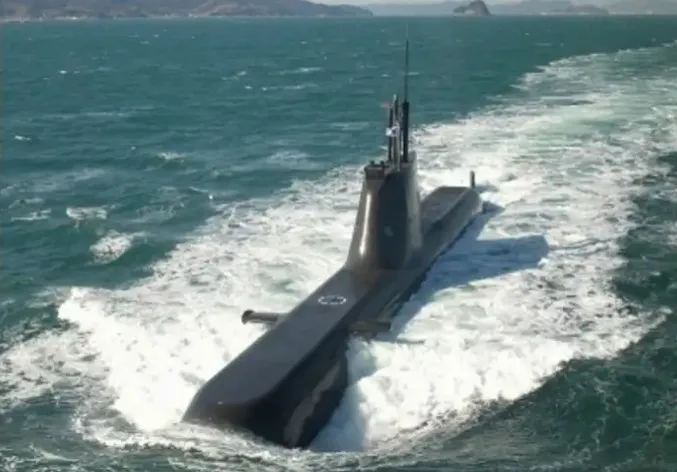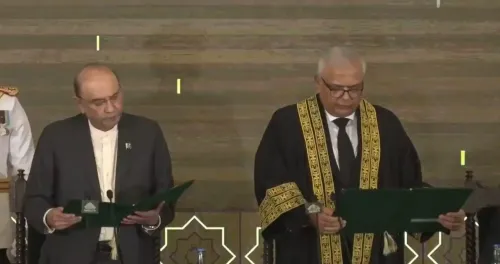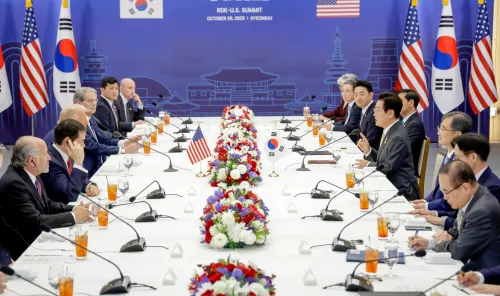Has the US Endorsed South Korea's Nuclear Submarine Initiative and Uranium Enrichment Drive?

Synopsis
Key Takeaways
- US endorses South Korea's nuclear submarine program
- Support for uranium enrichment and spent fuel reprocessing
- Significant economic investments pledged by South Korea
- Strengthening US-South Korea alliance against regional threats
- Future implications for US-China relations
Washington, Nov 14 (NationPress) The United States has officially endorsed South Korea's initiative to develop nuclear-powered submarines and expressed its backing for the ally's efforts to attain uranium enrichment and spent nuclear fuel reprocessing capabilities, as revealed in a joint fact sheet.
The White House released this document summarizing the outcomes from the meetings between President Lee Jae Myung and US President Donald Trump held at the White House in August and in Gyeongju, South Korea, last month, ahead of the Asia-Pacific Economic Cooperation summit.
This fact sheet, marking the first high-level bilateral official document since the commencement of the Lee administration in June, outlined several agreements on trade and security, including Seoul's commitment to invest US$350 billion in the US. In return, Washington agreed to reduce reciprocal tariffs on Korean goods from 25 percent to 15 percent, according to Yonhap news agency.
According to the document, "In line with the bilateral 123 agreement and subject to US legal requirements, the United States supports the process that will facilitate the ROK's civil uranium enrichment and spent fuel reprocessing for peaceful purposes." ROK stands for South Korea's official name, the Republic of Korea.
"The United States has granted approval for the ROK to construct nuclear-powered attack submarines."
The 123 agreement is a bilateral civil nuclear energy cooperation agreement that prohibits South Korea from enriching uranium and reprocessing spent nuclear fuel, allowing only for peaceful uses of nuclear energy.
Seoul has been advocating for amendments to this pact to secure enrichment and recycling rights to address energy security concerns and the increasing stockpiles of nuclear waste. Experts suggest that revisions to the pact or a separate agreement may be necessary for Seoul and Washington to proceed with nuclear-powered submarines.
South Korea aims to acquire four or more 5,000-tonne conventionally armed, nuclear-powered submarines by the mid-2030s.
The US's formal endorsement of Seoul's submarine initiative culminates a longstanding effort by the Asian nation to acquire these strategic assets in response to North Korea's escalating military threats.
This development coincides with the Trump administration's emphasis on the importance of allies in the Indo-Pacific region becoming stronger, particularly to counter the growing assertiveness of China.
Regarding trade, the fact sheet indicated that the US plans to lower sectoral tariffs on automobiles, auto parts, timber, lumber, and wood derivatives to 15 percent, although it did not specify when these reduced tariffs would take effect.
For pharmaceuticals, the US intends to implement a tariff rate not exceeding 15 percent on Korean products, while offering semiconductor tariff rates that are "no less favorable" than terms proposed in future agreements covering a chip trade volume equivalent to Korea's.
The document highlighted Seoul's commitment to invest $150 billion in the US shipbuilding sector and an additional $200 billion under a "Memorandum of Understanding related to Strategic Investments," which is expected to be signed by representatives from both nations.
To address Seoul's concerns regarding the impact of its investment on the foreign exchange market, the two parties agreed that South Korea will not be obligated to provide more than $20 billion in any calendar year.
On the defense front, it emphasized the US's commitment to defending its ally through the enduring presence of US Forces Korea (USFK).
However, the US stopped short of confirming the retention of the current troop level of approximately 28,500 USFK service members, despite ongoing speculation of a potential troop reduction as part of a regional force posture adjustment to focus more on countering Chinese threats.
The US reiterated its commitment to provide extended deterrence by leveraging the full range of its capabilities, including nuclear arms. Additionally, Lee and Trump pledged to bolster cooperation through consultation mechanisms, including the Nuclear Consultative Group (NCG).
Established in 2023, the NCG serves as the primary nuclear deterrence platform for the allies. It has not convened since the Trump administration took office in January, raising questions about its future and possible changes in operational principles.
As announced previously, the agreement solidified Seoul's intention to increase its defense spending to 3.5 percent of its gross domestic product as soon as feasibly possible, in line with Korea's legal mandates.
Seoul committed to spending $25 billion on US military equipment purchases by 2030 and shared plans for comprehensive support for the USFK amounting to $33 billion.
Moreover, the document included the leaders' commitment to advancing cooperation towards the transition of wartime operational control (OPCON), which the Lee administration aims to achieve before the end of its five-year term in 2030.
"With the US's support, the ROK pledged to expedite efforts to enhance its military capabilities to lead the combined conventional defense against the Democratic People's Republic of Korea," the document stated, referring to North Korea by its official name.
"This includes acquiring advanced US weapons systems and expanding bilateral defense industrial cooperation, particularly in high-tech weapons systems."
South Korea initially transferred operational control of its troops to the US-led UN Command during the Korean War (1950-53). Control was later shifted to the Combined Forces Command in 1978. Currently, wartime operational control remains under US jurisdiction, while South Korea regained peacetime OPCON in 1994.
The leaders also agreed to enhance the US's conventional deterrence posture against "all regional threats" to the alliance, including North Korea, as outlined in the fact sheet, which emphasizes Washington's request for Seoul to contribute to deterring Chinese threats.
"The two sides reaffirm relevant understandings established since 2006," it noted.
This appears to refer to a 2006 joint statement on "strategic flexibility" — a US initiative to broaden the operational scope of the current 28,500-strong USFK beyond the Korean Peninsula to encompass China-related contingencies, including potential Taiwan conflicts.
The 2006 document stipulated that South Korea acknowledges the "necessity" for strategic flexibility, while the US recognizes Seoul's position of non-involvement in regional conflicts against the will of the Korean populace.
In pursuit of reciprocal trade, the document emphasized a bilateral agreement to tackle Korea's non-tariff barriers.
"The ROK will collaborate with the United States to address non-tariff barriers impacting trade in food and agricultural products," it stated.
The efforts include setting up a "US Desk" focused on requests for US horticultural products and ensuring market access for US meats and cheeses that utilize specific terminology, alongside streamlining regulatory approvals for agricultural biotechnology products and addressing the backlog of US applications.
Additionally, both parties committed to safeguarding US companies from discrimination and unnecessary barriers concerning laws and policies related to digital services, including network usage fees and regulations for online platforms, as per the document.









